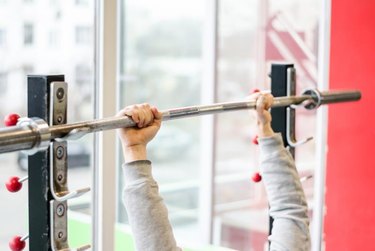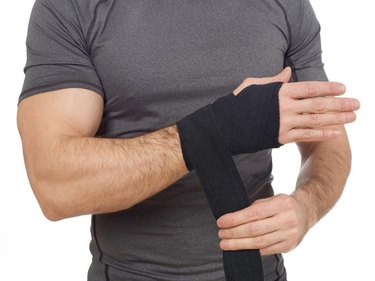
You better have strong pecs and a spotter when lifting a heavy barbell on the bench press. But, don't forget about the smaller links in the kinetic chain. Your wrists are an important joint in the process, as they are the first line of defense against that heavy bar crashing down onto your torso.
Even if your wrists can bear the weight, they may get extremely sore if you bend them back against the weight of the bar as you press up and down. Wrist pain makes a bench press unpleasant and, in some cases, impossible.
Video of the Day
Video of the Day
Wrist wraps, which are loops of cloth or leather that you wrap around the joint to make it more stable, seem to be the solution. But, it's not that easy. Over-reliance on wrist wraps can limit your wrist joint's range of motion and compromise your bench press, too.
Wrist wraps are a helpful tool to use during training, but they shouldn't become a dependence.
Why Use Wrist Wraps?
In proper bench press form, your wrists should stay neutral -- meaning they don't bend back under the force of the barbell. Bending backward can cause them to ache or develop tendinitis over time. It also limits your power, as you are creating a kink in the lever that draws a straight line from your chest muscles to the weight.
Read More: Bodybuilding Bench Press Proper Form
Wrist wraps help stabilize the extensors and flexors of the wrist so they're less likely to cave under pressure. How thickly you wrap them is a matter of choice, but the more dense the wrapping -- the greater the stability provided.

The Pros of Wrist Wraps
If you're worried your wrists will give out before your chest muscles, wrist wraps can be a boon. You can target the pectoralis major until it fails, without worrying as much about the strength of the small wrist joint. Targeting the pec muscles to failure is a goal of the bench press for many lifters, as it helps develop more strength and size.
The wrists are mobile joints, but not particularly stable. Wrist wraps offer this stability and, although you don't want to become dependent on them, they can be a helpful tool on your heaviest lifting sets and highest volume weeks.
The Cons of Wrist Wraps
If you become dependent on wrist wraps, the extensors and flexors of your wrists can grow weak. You'll lose flexibility in these muscles and, eventually, power in the bench press. Many of the strongest bench pressers don't wear wrist wraps because they've built up the wrist strength to bear a heavy bar.
Wrist wraps are tempting to use when you have an injury or limitations in flexibility. Using them to mask these problems so you can hit the bench press harder is a mistake. You're better off allowing wrist injuries to heal without subjecting them to heavy weights. If it's inflexibility you're dealing with, don't use wrist wraps in lieu of regular flexibility and strength exercises targeting the wrists, such as wrist circles and wrist curls.
Wrist wraps require a little technique in application, too. Some lifters wear them too low on their wrists and they don't do much good when bound around the forearm. Instead of wrapping straight across your wrist, think of supporting your wrist like a cast -- let the wrap cover a little above and a little below the wrist joint. This approach to wrapping provides stability.
Master Proper Technique First
Before using wrist wraps, ensure you have pristine bench-pressing form. Your hands should be about shoulder-distance apart and fixed on the bar with the proper grip. Avoid using wrist wraps as an excuse to keep poor grip habits.
Hold the bar with a "bulldog" grip, in which you grasp the bar with your thumb and index finger. Then rotate your thumbs slightly toward the floor -- as if you were a bulldog planting his feet.